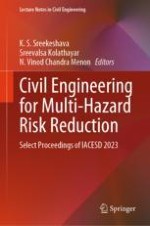2024 | OriginalPaper | Chapter
Machine Learning Algorithms for Classifying Land Use and Land Cover
Authors : N. R. Asha Rani, M. Inayathulla
Published in: Civil Engineering for Multi-Hazard Risk Reduction
Publisher: Springer Nature Singapore
Activate our intelligent search to find suitable subject content or patents.
Select sections of text to find matching patents with Artificial Intelligence. powered by
Select sections of text to find additional relevant content using AI-assisted search. powered by
